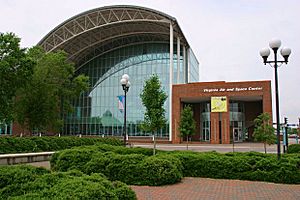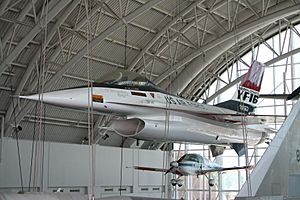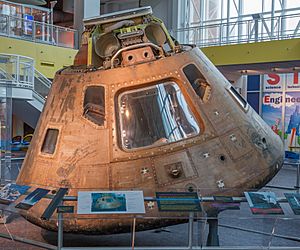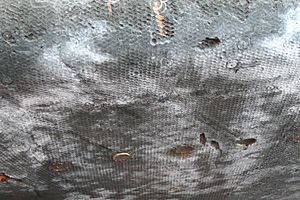Virginia Air and Space Science Center facts for kids
 |
|
| Established | 1992 |
|---|---|
| Location | Hampton, Virginia |
| Type | Aerospace |
| Visitors | 345,000 |
The Virginia Air and Space Science Center is an exciting museum in Hampton, Virginia. It's a place where you can learn all about airplanes, space, and science! This center also acts as a special visitor spot for NASA's Langley Research Center and Langley Air Force Base. The museum has a cool IMAX digital theater. They also offer fun summer camps about flying and space for kids.
One of the most famous items at the museum is the Apollo 12 Command Module called Yankee Clipper.
Contents
Exploring the Collection
The museum's main collection is inside a huge, three-story glass building. You can explore exhibits on two different floors. There's even a special walkway high up. From here, you can look down at the airplanes hanging in the air. Volunteers at the museum run an amateur radio exhibit. They show off old and new radio equipment. Sometimes, visitors can even talk to astronauts on the International Space Station!
Adventures in Flight Gallery
This gallery is all about how things fly. You can try out hands-on experiments. Learn about how airplane parts help control flight. You can also see how propellers work. There are even flight simulators where you can pretend to fly! Many airplanes hang from the ceiling in this area. Most of these planes have been restored. They are connected to flight research done by NASA and the Air Force nearby.
Here are some of the amazing aircraft you can see:
- A McDonnell Douglas DC-9-32 passenger plane. This plane was given to the museum by AirTran Airways. You can sit in the cockpit, first class, and coach seats. You can even try a Boeing 717 flight simulator inside!
- A B-24D "Liberator" heavy bomber. This plane has a film inside that makes you feel like you are flying with the pilots.
- A copy of the 1903 Wright Flyer.
- A replica of the Lockheed Martin F-22 Raptor cockpit.
- The nose section of a Grumman A-6 Intruder.
- A Bell P-39Q Airacobra.
- A Convair F-106B Delta Dart.
- A McDonnell-Douglas F-4E Phantom II.
- A Lockheed F-104C Starfighter.
- The nose section of a General Dynamics F-16 Fighting Falcon.
- The F-18 High Alpha Research Vehicle (HARV).
- A Republic F-84F Thunderstreak.
- A Grumman-American Yankee Aircraft.
- A Hawker Siddeley Kestrel XV-6A.
- A KITFOX Model 4 Speedster.
- A Pershing II Missile.
- A Piper J-3 Cub.
- A Pitts Special.
- A Rutan VariEze homebuilt light aircraft.
- A Schleicher ASW 12 Glider.
- A Stearman N2S-3 Trainer.
- A UH-1M "Iroquois" Helicopter.
- A YF-16 "Fighting Falcon".
Space Gallery
When you enter this gallery, it feels like you are launching to Mars! It tells the story of a trip to the Red Planet. Then, doors open into the main space exhibit.
Here are some of the cool things you can see:
- The Apollo 12 Command Module Yankee Clipper. This spacecraft orbited the Moon 45 times in 1969.
- The Apollo Lunar Excursion Module Simulator (LEMS). Astronauts at the Langley Research Center used this to practice landing on the Moon.
- A full-size copy of the Viking Lander.
- The hatch from Gemini 10.
- The Mercury XIV spacecraft.
- Sounding rockets like those launched from NASA's Wallops Flight Facility.
- A full-size copy of the Lunar Orbiter.
- Real rocks from Mars and the Moon.
- A Lunar Landing simulator.
Space Quest: Exploring Beyond
This hands-on space gallery is called "Space Quest: Exploring the Moon, Mars & Beyond." It has four main parts. These are Our Solar System, Living and Working in Space, Mars and the Moon, and Visions of Space Exploration.
Our Solar System Exhibit
This exhibit shows off models of the planets in our Solar System. Some of the models are huge! Saturn, Jupiter, Uranus, and Neptune hang almost 30 feet high. These are the biggest indoor planet models in any museum in the country. Jupiter is the largest model. It weighs over 750 pounds and is 10 feet wide! Saturn is eight-and-a-half feet wide and weighs 450 pounds. Its rings add another 495 pounds! Uranus and Neptune each weigh about 65 pounds. These models are made of strong Styrofoam. They are painted to look just like the real planets.
Smaller models of Earth, Mars, Venus, and Mercury are at eye level. The models are built to scale. This means Earth is about the size of a soccer ball. Mercury is about the size of a baseball.
IMAX Theater
The Riverside IMAX 3D Theater is part of the museum. It was the first museum theater in the world to have an IMAX Digital system. There are 447 IMAX theaters around the world. 256 of them are in the United States.
See also
- Air Power Park
- Buckroe Beach Carousel
- List of aerospace museums





